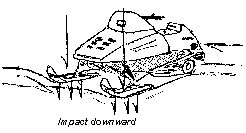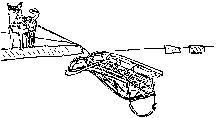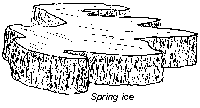Winter Trails
|
Nowadays people effortlessly travel many miles with snowmachines.
Long ago we had only foot power or dog power. We had to carefully
guard the energy available to travel.
It takes considerable energy to compress snow and make a trail. Breaking trail then and now are vastly different. |
||
Trails Set UpWhen it is cold, a trail will set up overnight. We used to make trail one day with an empty sled or snowshoes, and return the next day to haul a load. Overnight the snow crystals bond together, making a hard surface on the trail that supports the dogs and sled. Strategy in Hauling Meat or Wood Years ago, when we shot a moose or caribou, we often removed the entrails and organs, and left the animal until the next day. Even at –30° the animal doesn’t freeze if the stomach cavity is banked with snow. We snowshoed a trail home, constantly thinking of the return trip the next day with dogs. No sharp turns or big trees in the way! When we returned the next day, the trail we had snowshoed was fairly hard. We then butchered the moose or caribou and headed home on the packed trail. This method also has the advantage of giving the meat a chance to cool slowly, resulting in more tender meat. Traveling Strategy Much of the oldtimers’ traveling strategy was based on the fact that trails set up overnight. When snow was really deep, they often made camp early and snowshoed out several miles, returning after dark. The next morning, the trail was hard and easy traveling for the distance they had snowshoed. While snowmachines offer power we never considered possible before, there are conditions when they cannot pull a load and break trail at the same time. Often an operator will break trail the night before, and return the next day with the load. |
|||
Breaking TrailBreaking trail is difficult for man, dogs, and machines. It takes considerable energy to compact the snow. With dogs, I would much rather haul a big load on a hard trail than break trail with an empty sled. Once the dogs are up to their belly in snow, forward motion grinds to a halt. For dogs and machine alike, the most enjoyable trail to drive on is a hard trail that has just received two inches of fresh powder. The dogs have good footing, but the bumps are minimized by the cushion of fresh snow that also provides a very low friction surface. Machines also enjoy the soft cushion of fresh powder. |
|||

|
Wind-Covered TrailA trail seldom blows completely over in the timber, but will often be obliterated in the open places. Oldtimers walked with snowshoes, probing with a stick, to find the hardened trail in the open places. A good snowmachine operator can feel the hidden trail under the machine. Often trail markers are placed on both sides of open places so travelers know where to enter the brush or timber. At night, the shadows of a windblown trail can often be seen in the headlights of a snow machine or headlamp. |
||
|
|
High-Centered Trail
As the snow around the trail settles in March and April, it is hard to stay on the high trail. The sled or snowmachine tends to slip to one side or the other. That is why wise travelers make a wide trail from December through February, as they know a narrow trail will give them problems later. This process leaves a trail that is high, wide, and hard to travel on. Snow on either side of the trail is low and soft. However, in late spring, when the snow is gone from the tundra, a well-packed trail will still remain, giving the traveler a highway of snow surrounded by moss and bare ground. The high trail that was a problem in March and early April becomes a blessing in late April. When a snowmachine runs over a trail, it goes up and down with the terrain. As it comes down after a bump, the impact, or force of the machine, compresses the snow. This makes the depression on the far side of the bump deeper. It doesn’t take long for the trail to be so rough it is painful to travel, particularly if there is a loaded sled behind. The impact on the hitch and tongue of the sled is constant. There is no way to avoid this phenomena. Since force equals mass times acceleration, the heavier a machine is and the faster it is going, the quicker it will ruin the trail. The effect can be minimized by going slowly but, sooner or later, someone will have to break a new trail, and the process will start over. Downhill skiers know quite well how “moguls” come into being. Dogsleds and cross country skiers seldom travel fast enough with enough weight to have this type of problem. |
||
|
|
OverflowWhen river or lake ice settles or when creeks overflow, water seeps on top of the ice but under the insulating blanket of snow. Once the overflow is exposed to the cold air by a passing sled or machine, it freezes quickly. The next time the traveler comes by, there is a rough, hard, icy highway to travel on. Overflow has always been a problem in the late winter and spring months. Once the machine is stuck, put brush under the machine providing surface area to stay above the water. Get momentum again and don’t stop short of safety. Ruined backs and frozen feet are always possible during efforts to get snowmachines out of overflow, which can be a foot deep at –30°F. Dogs don’t get stuck in overflow the way snowmachines do, though their feet ice up with snowballs. When they pull the ice off, they also pull hair, making their feet sore. Dogs with webbed feet suffer more than others. |
||
|
|
Bad IceWhen traveling on bad ice with dogs, we often string the dogs out with a long towline, single file rather than double. This keeps the combined weight of the team, sled and driver over a larger area. If the sled falls through, there are several dogs far ahead on solid ice who can pull the sled out.
Of course, when dogs are spread out like this, it is very difficult to travel in the timber. Some dog or someone will get slammed into a tree as the leader is around a bend in the trail others haven’t approached yet. Swimming across creeks was standard practice in the spring. The driver gets up on the railing of the sled, keeping the back of the sled down, the front up, hoping the creek isn’t too deep. Some of the dogs get across the creek and onto solid ground when the sled is entering the water. If this looks marginal, the driver can extend the towline with a long dog chain. This assures that some dogs are on solid ground when the sled hits the water. Snowmachines don’t have the luxury of being able to swim, although they can skim on water for a ways if they have enough inertia. Some drivers have overestimated the ability of their machine to travel on thin ice and water. They get a cold bath and a long walk home. |
||
|
|
Sunny and Cloudy DaysIn winter, when the sun is shining, there are shadows everywhere that indicate any unevenness of the snow’s surface. The light is coming from one source in one direction. When the sky is overcast or foggy, it is very difficult to see uneven features in the terrain. The snow’s surface looks flat because light is reflected in all directions. There are no shadows. This makes travel somewhat dangerous. One time I almost walked off an eight-foot bluff. Everything looked flat. On an overcast day, it is hard to see the indentations on the river that could indicate that the ice has melted away beneath the snow’s surface. It is safer to travel new country on sunny days. |
||
|
|
|
||

|
Activities
|
||

|
Student Response
|
||

|
Math
|

 A
trail that is obliterated in January or February will show up later
as the soft snow around it settles.
A
trail that is obliterated in January or February will show up later
as the soft snow around it settles.
 When
the next machine comes down the trail, it goes over the same bump,
but comes down harder because the depression is deeper. This compacts
the snow more, making the depression deeper.
When
the next machine comes down the trail, it goes over the same bump,
but comes down harder because the depression is deeper. This compacts
the snow more, making the depression deeper.
 If
the front of the sled goes under the ice, the traveler is in big
trouble, so it is important to keep the front up when this happens.
The harder the dogs pull, the more difficult it is to get the front
of the sled above the ice.
If
the front of the sled goes under the ice, the traveler is in big
trouble, so it is important to keep the front up when this happens.
The harder the dogs pull, the more difficult it is to get the front
of the sled above the ice.
 Fall
and Spring Ice
Fall
and Spring Ice